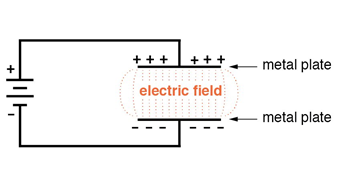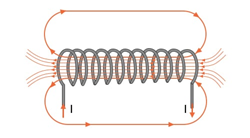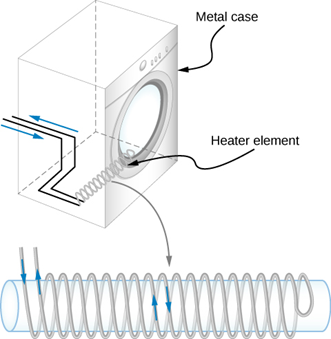Electricity and electronics: State and apply principles and components used in electronics
Unit 1: Capacitance and inductance
Leigh Kleynhans
Unit 1 outcomes
By the end of this unit you will be able to:
- Define capacitance.
- Define inductance.
- Describe the applications of capacitance and inductance.
What you should know
Before you start this unit, make sure you can:
- Understand the concept of electric field strength around charges and capacitance, and the calculation of capacitance. Refer to level 3 subject outcome 4.1 unit 3 if you need help with this.
- Understand the concept of electromagnetic induction. Refer to level 3 subject outcome 4.2 unit 2 if you need help with this.
Introduction
You have already learnt that a capacitor is a device used to store electrical charge and electrical energy. In this unit you will learn about capacitance, the amount of electrical charge and energy capacitors can store.
You have also learnt that induction is the process by which an is induced by a changing . In this unit, you will learn that the physical quantity that determines how effective a device is in doing this is called inductance.
Capacitance
Capacitance exists wherever conductive material is separated by insulating material. Capacitors can store energy as an electric field.

The property of a capacitor to store charge on its plates in the form of an electrostatic field is called the capacitance of the capacitor. The capacitance of a capacitor is determined by the surface area of the conductive plates and the distance of separation between them. Altering any two of these values alters the value of its capacitance. Because capacitors store the energy of the electrons in the form of an electrical charge on the plates, the larger the plates and/or smaller their separation the greater the charge that the capacitor holds for any given voltage across its plates. In other words, larger plates, smaller distance, more capacitance.
The capacitance of a capacitor can be calculated using the following formula: [latex]\scriptsize C=\displaystyle \frac{Q}{V}[/latex].
Inductance
Inductance is a property of a current carrying conductor to build a magnetic field. Inductance indicates the amount of voltage that will be generated by an inductor because of changes in the rate of charge movement through the inductor.
All conductors, such as wires, have inductance. To create an inductor, we use techniques that strengthen a magnetic field and thereby increase inductance. A basic inductor is simply a coiled wire. Figure 2 shows how this structure concentrates magnetic field lines.

Inductance is the property of a device that tells us how effectively it induces an emf in another device. For a given coil, the ratio of the emf to the rate of change of the current in the coil is a measure of the inductance.
A large inductance may or may not be desirable. We want a transformer to have a large inductance, because its purpose is to induce an emf. But an appliance, such as an electric clothes dryer, can induce a dangerous emf on its metal case if the inductance between its coils and the case is large. One way to reduce inductance is to counter-wind coils to cancel the magnetic field produced.

Applications of capacitance and inductance
Voltage sources provide the energy that allows an electrical circuit to carry out its intended function. However, a circuit is not simply divided into sources that supply energy and components that consume energy.
Capacitors and inductors are used to store energy and can function as temporary energy sources in circuits. Inductance and capacitance are independent properties of two different electrical components. While inductance is a property of a current carrying conductor to build a magnetic field, capacitance is a measure of the ability of a device to hold electrical charges.
A component’s capacitance is a critical circuit-design parameter because it influences the rate at which voltage (or current) changes during charging and discharging. Higher capacitance means that the voltage across a capacitor will increase more slowly (when it is charging) and decrease more slowly (when it is discharging).
If a circuit with a capacitor is disconnected from a power supply, the capacitor will temporarily maintain voltage. If a circuit with an inductor is disconnected from a power supply, the inductor will temporarily maintain current. Another way of saying this is that capacitors ‘resist’ changes in voltage and inductors ‘resist’ changes in current.
Both these properties are used in various applications. For example, they are widely used in power networks, voltage-regulator circuits, and electronic circuit filters that regulate frequency signals.
Summary
In this unit you have learnt the following:
- Capacitance is the ability of a capacitor to store charge in the form of an electric field.
- Capacitance of a capacitor is dependent on the surface area of the conductive plates and the distance of separation between them.
- Inductance is the property of a device that determines how effectively it induces an emf in another device.
- Inductance is dependent on the ratio of the emf to the rate of change of the current in the coil.
- Capacitance is applied in electrical circuits to ‘resist’ changes in voltage.
- Inductance is applied in electrical circuits to ‘resist’ changes in current.
- Examples of the application of capacitance and inductance are in power networks, voltage-regulator circuits, and electronic circuit filters that regulate frequency signals.
Unit 1: Assessment
Suggested time to complete: 15 minutes
- Define capacitance.
- Define inductance.
- Tabulate the differences between capacitance and inductance.
- How are the properties of capacitance and inductance applied in electrical circuits?
The full solutions are at the end of the unit.
Unit 1: Solutions
Unit 1: Assessment
- Capacitance is the property of a current-carrying conductor to hold and store charge.
- Inductance is the property of a current-carrying conductor to generates a magnetic field.
- .
Capacitance Inductance Property of a current-carrying conductor to hold and store charge Property of a current-carrying conductor to generate a magnetic field Based on creating an electric field Based on a magnetic field Associated with electrical components called capacitors which are parallel plates separated by a dielectric Associated with electrical components called inductors which are coiled current-carrying wires ‘Resist’ changes in voltage ‘Resist’ changes in current - Capacitance and inductance are used in power networks, voltage-regulator circuits, and electronic circuit filters that regulate frequency signals.
Media Attributions
- img01_Figure1 © OpenStax is licensed under a CC BY (Attribution) license
- img02_Figure2 © OpenStax is licensed under a CC BY (Attribution) license
- img03_Figure3 © OpenStax is licensed under a CC BY (Attribution) license
electromotive force, the electrical energy supplied per coulomb of charge
the measurement of the total magnetic field that passes through a given surface area
